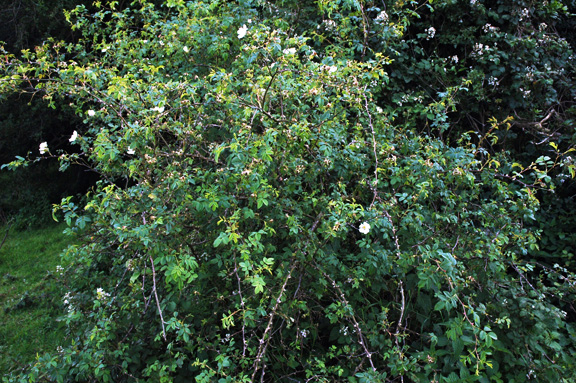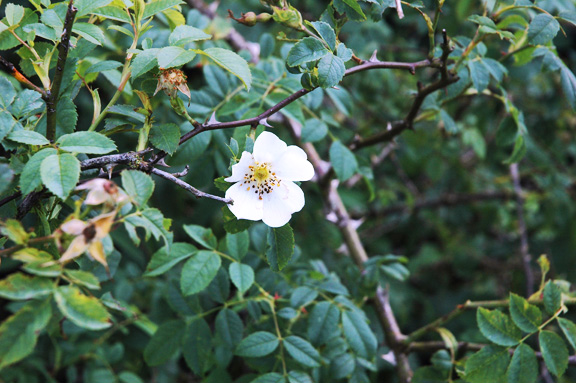| General Description | A medium, deciduous shrub native to Europe and later introduced to North America; it is considered an ancient Rose from England that has a sweet apple-like scent. It is usually loose and branchy in shape and grows well along hedges. |
| ID Characteristic | It has showy, singular flowers that bloom in early May-July. These are characterized by five wide, pink and white petals around a yellow center. The leaves are opposite, serrulate and are medium to light green in colour. This plant has small fruit (hips) which ripen and turn red in the fall. Its bark is also green, turning to brown, red, and purple in the winter. It has hooked, dark red prickles along its stem. |
| Shape | Typically branching in shape. Rosa micrantha is generally loose and straggling. As the plant ages, the stems increase in width and the thorns increase in size. In the winter months, the plant maintains its branching shape and its form is highlighted by its red fruit that stays through the late fall and winter months. |
| Landscape | It can be used as a hedge plant in small gardens or in larger urban plantings or parks. |
| Propagation | Propagation through seeds will most likely require a 2 year stratification process, although alternative options have been developed. A possible way to shorten this time would be to scarify the seeds and place them in damp peat at a temperature of 27 – 37°C for 2 – 3 weeks. They are then kept at a temperature of 30°C for the next 4 months (allowing germinate to begin). Seeds that have been stored prior to planting should be planted as early as possible and stratified for 6 weeks (at 50°C); this may take up to two years. Once the seedlings are large enough to handle, place them in small individual pots and plant outside during summer months once over 25 cm in height. Propagation through cuttings from a mature growth will require a pencil thick shoot (roughly 20 to 25 cm long). Plant in a sheltered outdoor area or cold frame. This will take up to 12 months to establish, but a higher percentage of these cuttings typically succeed. Propagation through division is done during their dormant period. Plant and layer them directly into their permanent positions in the landscape; this will take up to 12 months to establish. |
| Cultivation | Rosa micrantha thrives in calcareous soils and in heavy, well-drained clay soil. It prefers circum-neutral soils (between ph 6.5 and 7.5). Full sun to dappled shade, and can withstand colder temperatures well. It does not thrive in wet soils and will not grow well alongside boxwood. It is closely related to the Rosa eleganteria and will hybridize with other members of this genus. |
| Pests | There are no known pests or diseases; however, it is notably susceptible to honey fungus. Herbivores like birds are attracted to the sweet smelling flowers and fruit but the presence of thornes help to limit their interest. |
| Notable Specimens | New York Botanical Collection: Puno, Peru (Near the University), Public Display (NYBG: Rosa micrantha, 2010). |
| Habitat | Open valleys, grasslands and along sea cliffs. |
| Bark/Stem Description | Colour ranges from green to dark brown. The texture is thin and smooth for both mature and immature bark with young bark maintaining a light green colour. |
| Flower/Leaf Bud Description | Small and scaled. It has three or more scales that overlap, taking on a red colour in the winter months. Buds are ovate in shape and have striate scales. |
| Leaf Description | Opposite and oddly pinnate with 5 leaflets per leaf. They are small, deep and waxy green. Leaf margins are serrulate and have pinnate venation. |
| Flower Description | Small and oblong. Coral pink to white in colour and arranged around a white eye with yellow stamen. Flowers are five petaled and are solitary, perfect and complete (meaning they are hermaphroditic). The most relied upon pollinators are bees and the flowering period is in June. |
| Fruit Description | 1.5-2 cm in size, bright red and ovate in shape. Ripens in late fall to early winter. They grow singularly, swelling from underneath the flower and are
indehiscent. The fruit has a thin layer of flesh and small white seeds. It has small hairs around the base of the fruit that can be dangerous if
ingested, so it is important to remove them. |
| Colour Description | Leaves are a medium to dark waxy green, turning to a deep red and brown in the fall and winter. Flowers are a light to coral pink, with a white center and yellow stamen. Bark in early growth is an olive green, turning to a dark brown/red in later years. Fruit is a deep red when ripe, but ranges in colour from a light green to a deep pink prior to this. Thorns range from a light red to a deep scarlet. |
| Texture Description | Texture is medium to fine, and does not change seasonally. |

